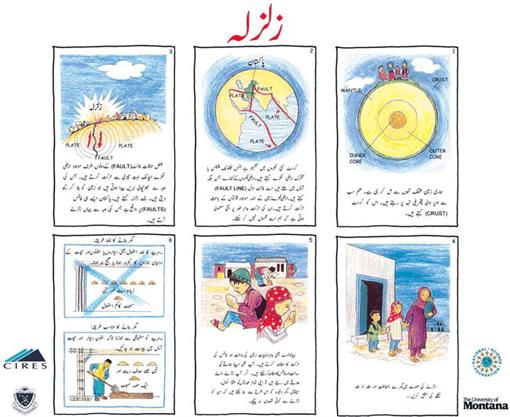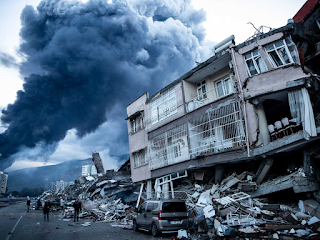Kharpocho Fort, also known as Mindoq Khar, is a historic fort located on a hill overlooking Skardu city and the Indus River in Baltistan, Pakistan. It was constructed by Ali Sher Khan Anchan, the ruler of Skardu during the 16th century. The fort was built to serve as a strategic point to repel invasions from neighboring regions and later as a prison for political prisoners. Kharpocho Fort now serves as a popular tourist destination due to its rich historical significance and breathtaking views of the city and surrounding mountains.
Saturday, 8 April 2023
Friday, 7 April 2023
The Northern Areas of Pakistan
.jpg) The Northern areas of Pakistan are considered to be some of the most beautiful and breathtaking regions in the world, with stunning natural landscapes, ranging from high mountain peaks to crystal clear lakes, and peaceful valleys. These regions include Gilgit-Baltistan, Khyber Pakhtunkhwa, and Azad Jammu and Kashmir.
The Northern areas of Pakistan are considered to be some of the most beautiful and breathtaking regions in the world, with stunning natural landscapes, ranging from high mountain peaks to crystal clear lakes, and peaceful valleys. These regions include Gilgit-Baltistan, Khyber Pakhtunkhwa, and Azad Jammu and Kashmir.Tourism in the Northern areas of Pakistan has seen a significant boost in recent years, with many travel and tour operators offering various services such as guided tours, adventure sports, and accommodations. This has helped boost the local economy and promote the region's unique culture and natural beauty to visitors from around the world.
Visitors to these regions can enjoy a variety of outdoor activities such as trekking, mountaineering, white water rafting, boating, and fishing, among others. The region is also known for its rich history and cultural heritage, with several ancient forts, shrines, and museums that showcase the region's unique identity and background.
Baltistan
The people of Baltistan are primarily of Tibetan origin and follow a blend of Tibetan Buddhism and Sunni Islam. The region has a rich cultural heritage, with traditional music, dance, and handicrafts. Baltistan is also home to several important historical and cultural sites, including ancient forts, monasteries, and archaeological remains.
Tourism is a significant industry in Baltistan , with many visitors coming to explore the region's natural beauty and cultural attractions. Popular tourist destinations include Skardu, Shigar Valley, Kachura Lake, Satpara Lake, Deosai Plateau, and the historic town of Khaplu.
, with many visitors coming to explore the region's natural beauty and cultural attractions. Popular tourist destinations include Skardu, Shigar Valley, Kachura Lake, Satpara Lake, Deosai Plateau, and the historic town of Khaplu.
Definition of Firstaid
First
earthquakes in Pakistan
be at high risk of earthquakes. One of the most dangerous zones is the boundary between the Indian and Eurasian plates, which runs through the northern part of Pakistan, including the Kashmir region. This zone has experienced several significant earthquakes in the past and is considered to be at high risk for future seismic activity.Some of the most significant earthquakes in Pakistan's history have occurred in this region. In 2005,
a magnitude 7.6 earthquake struck the Kashmir region, causing widespread devastation and loss of life. The earthquake was felt across the region and triggered landslides and rockfalls that further exacerbated the damage.Another high-risk zone in Pakistan is the Makran subduction zone, which is located along the
southwestern coast of the country. This zone is where the Arabian plate is pushing under the Eurasian plate, causing significant seismic activity. While the region has not experienced a major earthquake in recent history, experts warn that the region is at high risk for future earthquakes and tsunamis.Given the high risk of earthquakes in Pakistan, it's essential to be prepared and have
emergency plans in place. This includes building structures that are designed to withstand seismic activity, developing early warning systems, and having supplies and emergency procedures established in case of a quake. It's also vital for the government to continue investing in earthquake research and monitoring to better understand and prepare for potential seismic activity.In conclusion, Pakistan is located in a seismically active region, and there are several high-
risk zones that are at risk of future earthquakes. It's essential to be prepared and have plans in place to mitigate the damage and loss of life that can occur in the event of a seismic event. The government, as well as individuals and communities, should continue to invest in reducing earthquake risk and improving resilience
Aftershocks of earthquakes
Aftershocks are a common occurrence
after an earthquake, and they can continue for
days, weeks, or even months after the initial earthquake. Aftershocks happen because the initial earthquake causes a release of stress in the Earth's crust, which can then cause additional shifts and seismic activity.Aftershocks may vary in intensity and
duration. They can be more severe than the initial earthquake, or they can be relatively mild. Aftershocks that are of similar magnitude to the initial earthquake can cause further damage, exacerbating already weakened structures and infrastructure. In some cases, aftershocks can even trigger new landslides or tsunamis.
The frequency and severity of aftershocks depend on several factors, including the magnitude and location of the original earthquake, the properties of the Earth's crust in the region, and the type of fault that caused the quake. Scientists use data from aftershocks to better understand the characteristics of earthquakes and to update earthquake risk models.
After an earthquake, it's essential to be prepared for aftershocks. The best course of action is to follow the same safety procedures as for the initial earthquake, seeking shelter and staying away from damaged and hazardous areas until it has been established that it is safe to return. Aftershocks can occur without warning and can be just as dangerous as the initial earthquake.
In conclusion, aftershocks are a natural part of the earthquake process and can be just as dangerous as the initial quake. They can cause further damage to already weakened structures, and it's essential to be prepared and follow safety procedures in the aftermath of an earthquake. Scientists continue to study aftershocks to better understand earthquake activity and improve our ability to predict and respond to earthquakes.
earthquakes
strike our planet. They occur when tectonic plates beneath the earth's surface suddenly shift and release energy, causing the ground to shake and potentially causing destruction to structures and infrastructure. Earthquakes have been recorded throughout history, and their impact can be felt on a global scale, both in terms of the physical damage they cause and the psychological trauma that can result from experiencing their effects.Earthquakes have the power to cause widespread damage and loss of life. They can
trigger landslides, tsunamis, fires, and even volcanic eruptions, all of which can contribute to the destruction and loss of property and human life. Earthquakes also have a broader impact on the environment, disrupting ecosystems and causing damage to critical infrastructure like water and power lines.Despite the danger they pose, Earthquakes are incredibly difficult to predict, and we
currently have limited technology for detecting and monitoring them. Because of this, it's important to have solid earthquake preparedness plans in place. This includes ensuring that buildings are constructed to withstand seismic activity, making sure there are strong early warning systems in place, and having supplies and emergency procedures established in case of a quake.In conclusion, Earthquakes are one of the most powerful and significant natural
disasters that we face as a planet. While we have made progress in preparing for and mitigating their impact, there is still much work to be done in understanding and predicting their occurrence. With continued research and planning, we can hopefully decrease the damage they cause and protect the lives and property of those who are affected by them.
















